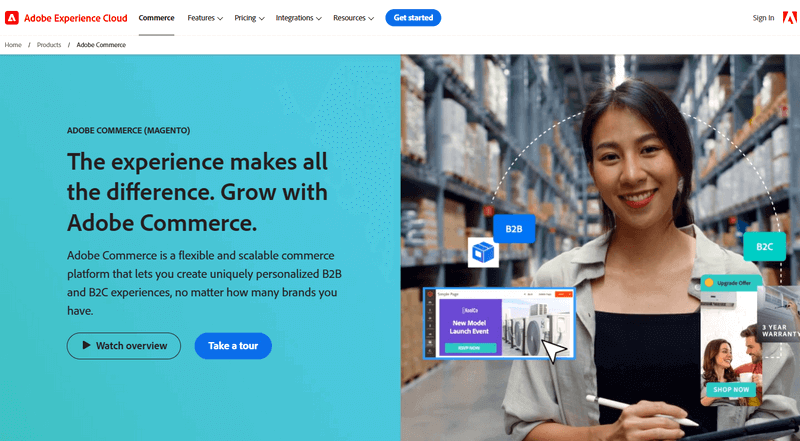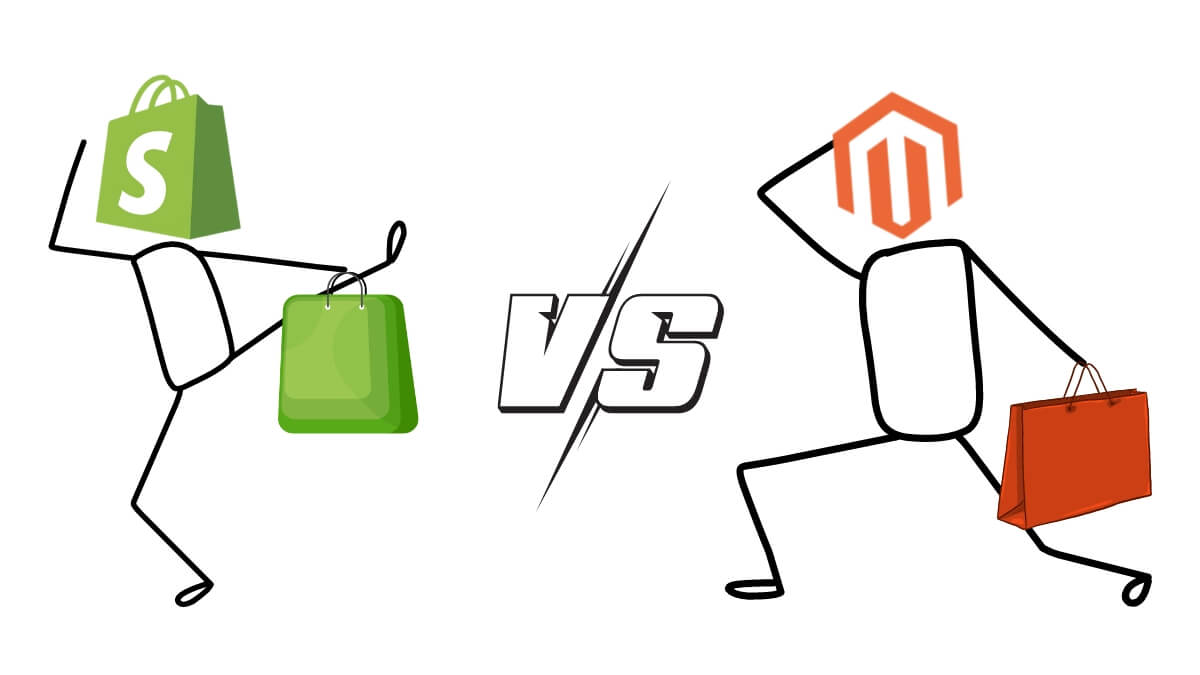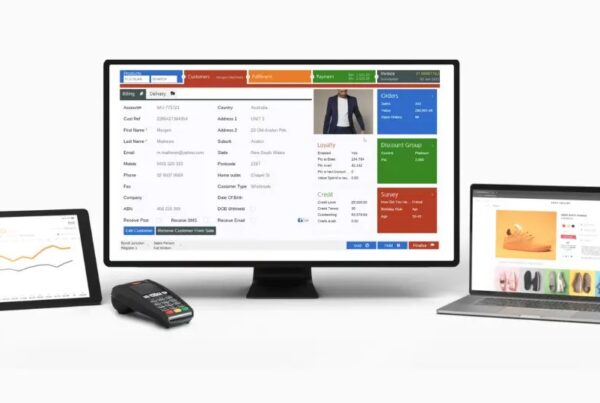Choosing the right eCommerce platform for your online store can be tough, especially when deciding between Magento vs Shopify. With Shopify currently owning a 10.32% market share and Magento coming at 2%, there’s no doubt that these two platforms are among the top choices for retailers.
But which option is truly better for your requirements? That’s what Magestore aims to find out in this comprehensive comparison chart. We’ve taken everything that most likely leads you here – pricing, features, scalability, etc. – to provide an unbiased look at Magento vs Shopify by leveraging our years of experience in retail and Magento development.
So, without further ado, let’s get down to business.
Magento Adobe Commerce vs Shopify: The basics to know
Every leading eCommerce platform has its pros and cons. What works best for a rapidly growing company may not work well if you’re on a shoestring budget. Now, let’s consider the overview, ideal use cases, key features, and pros and cons of Shopify and Magento.
Magento overview (Adobe Commerce) – 141,912 live stores
Magento is a PHP eCommerce platform that allows programmers to build websites for online sales. It belongs to the top 5 most powerful eCommerce platforms, with more than 141,000 live stores. Since its launch in 2008, Magento has built a reputation for its solidity and flexibility.

Magento is available in three editions: Magento Open Source (Magento Community), Adobe Commerce (Magento Enterprise), and Adobe Commerce Cloud. In 2028, Adobe bought Magento for $1.68 billion to enhance their commerce offerings and better serve global B2B and B2C customers.
Until now, the platform remains a top choice for businesses that need scalability and customization when they grow. While Magento alternatives exist, few can match Magento’s capacities to handle complex operations. Another key advantage is its strong developer community and extensions marketplace that lets you customize your store to fit your exact needs.
Best for:
- Mid-size to large enterprises with complex needs
- B2B businesses with intricate pricing and catalog structures
- Retailers with multiple stores or brands under one umbrella
- Companies with high-volume sales or large product catalogs
- Businesses with a dedicated IT team or budget for developers
- Companies requiring highly customized eCommerce solutions
- Organizations looking for an open source platform that allows extensive modification and complete control over their eCommerce ecosystem
Shopify overview – 2,393,785 live stores
Shopify has been a well-known name in the eCommerce space since 2006. Fast forward to 2024 and Shopify is powering over 2 million businesses in over 175 countries. Since going public in 2015, Shopify has watched its numbers climb month-on-month in cash and users.

What we like about Shopify is that it’s made for all kinds of users. If you’re new to website building, you’ll find it definitely simple to use.
For those running larger operations, Shopify has robust tools to support your needs. They have a Shopify app store where you can add unique features to beef up your site’s functionality.
What makes Shopify a strong solution is its multi-channel functionality. That allows you to sell through different channels, whether in social media, online markets, or offline using a point of sale system.
Best for:
- Entrepreneurs and startups launching their first eCommerce venture
- Small to medium-sized businesses looking to establish an online presence
- Larger enterprises seeking a scalable and customizable eCommerce solution (Shopify Plus)
- Dropshipping businesses
Magento vs Shopify comparison: Key features
Features | Magento | Shopify |
Open source | ✔️ | ❌ |
Hosting included | ❌ (But ✔️ for Adobe Commerce Cloud) | ✔️ |
Unlimited bandwidth | ❌ | ✔️ |
Multi-store management | ✔️ | ❌ |
Customizable themes | ✔️ | ✔️ |
SEO tools | ✔️ | ✔️ |
Mobile optimization | ✔️ | ✔️ |
Third-party integrations | ✔️ | ✔️ |
Built-in payment gateway | ❌ | ✔️ (Shopify Payments) |
Over 100 payment gateways | ✔️ | ✔️ |
Inventory management | ✔️ | ✔️ |
Order management | ✔️ | ✔️ |
Abandoned cart recovery | ✔️ | ✔️ |
Product reviews | ✔️ | ✔️ |
Discount and promotion tools | ✔️ | ✔️ |
Analytics and reporting | ✔️ | ✔️ |
Multi-currency support | ✔️ | ✔️ |
Multi-languages support | ✔️ | ✔️ |
Custom URL structures | ✔️ | ❌ |
B2B features | ✔️ | △ (limited) |
Scalability | ✔️ | ✔️ |
Customer segmentation | ✔️ | ❌ |
Content staging | ✔️ | ❌ |
Automated marketing tools | ✔️ | ✔️ |
Social media integration | ✔️ | ✔️ |
App Marketplace | ✔️ | ✔️ |
Free SSL certificate | ❌ | ✔️ |
PCI-DSS compliant | ✔️ (not apply to Magento Open Source) | ✔️ |
Built-in fraud protection | ✔️ | ✔️ |
Magento vs Shopify: Pros and cons
Even though both are mighty, popular and pack a punch with features, they service different business needs and types. To determine between Shopify and Magento, you need to understand each of their unique selling propositions. Here’s a no-nonsense rundown on the pros and cons of each.

Magento pros
- Super flexible and customizable: Magento’s open source nature enables unlimited customization possibilities. You can tailor everything with Magento website builder to your needs, from storefront design to the backend process.
- Packed with built-in features: Magento has many features that come out of the box, such as multi-store management, advanced product options, and even order management. Besides, Adobe Commerce solutions support over 80 languages and a wide range of global currencies.
- Advanced SEO support: Magento has one of the best SEO functionalities, including customizable URLs, meta information, and sitemap generation.
- Ready for mobile and omnichannel: The platform provides responsive design themes and progressive web app (PWA) capabilities for a superior mobile shopping experience. Moreover, it supports an omnichannel approach that unites online and offline stores. And with the Magento Order Management System, merchants can offer buy online, pick up in-store (BOPIS) to amplify in-store sales by up to 37%.
- Big supportive community: Magento has a large active community of developers, with 480,000+ forum members, so you can find solutions to most issues easily. Also, Magento Marketplace provides over 5,660 extensions, so you can easily add new functionality without custom development.
- Robust integration: Unlike other Magento competitors, its powerful APIs and web services allow easy integration with various CRM, ERP, PIM, and OMS solutions, including popular systems like SAP, Oracle, Microsoft Dynamics, etc. For example, you can integrate Magento with Exact ERP to have a Magento Exact integration system.
- Advanced performance monitoring tools: Magento 2 has a lot of solid built-in capabilities to monitor performance with real-time indicators.
- Scale alongside your business: Magento can handle catalogs with 10 million products and thousands of simultaneous shoppers. So, it’s unsurprising that Magento merchants can handle hundreds or thousands of orders daily during peak seasons.
- GDPR and other compliance laws: Magento gives you the tools and capabilities to meet GDPR and other data protection regulations, including Consent Management, Data Encryption, Security Patches, PCI DSS Compliance, Customer Data Deletion, etc.
Magento cons
- Require some tech expertise to set up and manage: Setting up a Magento store typically requires PHP, MySQL, and server management knowledge. Thus, it normally takes 2–3 months on average to launch a Magento store, compared to more user-friendly platforms.
- Take time, effort, and budget to customize: Ongoing management often requires an IT team or, at the very least, a Magento-certified developer, as even minor customizations typically necessitate professional assistance.
Due to its complex architecture, custom development for Magento will take 30-50% more time than other platforms.
- Some specific extensions and plugins are pricey: Typically, high-quality extensions of Adobe Commerce cost between $100 and $500+, and some enterprise-level modules, such as CRM integration, advanced reporting, and multi-warehouse management, cost over $1,000. Usually, scripting and compatibility issues between extensions can cause extra development effort, increasing the overall extension budget, often by 25-40%.
- Costs can add up with hosting, development, and maintenance: Dedicated Magento hosting can run for $100–$500+ per month. You may spend an initial investment of between $20,000 and $100,000+ for a primary custom Magento store (depending on the size and complexity). Ongoing maintenance, including security updates to performance optimization, can typically cost $500–$3,000 monthly.
- Limited access to Magento’s technical support: Magento online stores usually have to keep aside a budget for 3rd-party support services, anywhere between $1,000–$5,000 annually. Also, critical issues need immediate Magento experts, where you can expect to shell out premium rates, 50–100% more than usual development costs.
Shopify pros
- User-friendly interface, suitable for beginners: The easy-to-use interface of Shopify lets even non-tech-savvy people set up and start their very own online stores.
- A wide range of beautiful, customizable themes: There are over 200 professional themes on the Shopify platform with free and paid versions. These themes are mobile responsive and can be tailored to your brand.
- Robust app store with 10,309 apps to extend functionality: Your businesses can add new features without modifying these apps.
- Reliable hosting with vital uptime (99.98%) and fast loading times: Shopify’s cloud-based infrastructure ensures high availability and loading speeds.
- Built-in tools to help with SEO and marketing: Shopify gives you many built-in SEO and marketing tools like customizable meta tags, sitemaps, social media integration, loyalty programs, gift cards, discounts, etc.
- Integrated Shopify Payments with competitive transaction fees: By using Shopify Payments, businesses can save up to 2% on transaction fees compared to an external payment gateway.
- 24/7 customer support: Shopify offers round-the-clock support via phone, email, and live chat.
Shopify cons
- Limited customization for advanced users unless using code: Shopify is easy to use but can be limiting if your business has special customization needs. Most advanced customizations will require some familiarity with Shopify’s liquid language.
- Premium themes and advanced customization need a developer: Basic customizations are easy, but for anything more advanced, you’ll need to hire a Shopify Expert for $50–$150+ per hour.
- Essential apps add to monthly costs: Many important features are available only through paid apps. While it depends on your store’s specific needs, most Shopify stores will use between 6 and 10 paid apps. Thus, it increases your monthly costs from $50 to $250+.
- Slower loading with extensive inventories or many apps: Stores dealing in a broad product base (10,000+ SKUs) or offering a wide range of applications might have slower load times.
- Advanced sales features need higher plans or 3rd-party apps: Advanced report builders or real-time shipping rates are locked behind higher-tier plans or paid apps.
- Extra fees without Shopify Payments: External payment gateways will impose 0.5% to 2% extra transaction charges.
- Costs rise quickly as your business grows: Many companies need to raise their plan level as they scale. Moving from Basic to Shopify or Advanced plans costs $39 to $399 monthly, and transaction fees (outside of Shopify Payments) can increase by up to 2% per transaction.
- Limited control over server settings and data security: Shopify’s hosted nature means you have limited access to the underlying server configuration. This can be a deal breaker if your company has specific security restrictions or if you work in a highly regulated industry.
- Multi-language setup requires extra apps or configuration: Unlike Magento, Shopify doesn’t have built-in multi-language support on all plans. To set up a multilingual store, you must use paid apps or do some code work.
- Updates can disrupt integrations or require theme and app updates: Sometimes, Shopify’s regular platform updates can conflict or cause issues with existing themes or apps. On average, store owners have reported spending 5–10 hours per significant update to ensure everything works well.
18 factors to consider choosing Magento or Shopify
So, you’ve seen the pros and cons of Magento vs Shopify. Feeling overwhelmed? Yeah, we were too! Selecting the perfect eCommerce platform for your business is like choosing a home. What works for one company might not work for another. Next, let us break it down for you into 18 factors.
1. Pricing
How does Magento commerce vs Shopify differ in terms of pricing?
- Shopify charges $39/ month for the Basic plan and $2,300/ month for Shopify Plus.
- Magento ranges from the free Community Edition to the Enterprise Edition at up to $125,000/ year.
So even when comparing the highest-tier plans (Shopify Plus vs Adobe Commerce Cloud), Adobe Commerce pricing is still much more expensive for merchants as you consider hosting, development, and maintenance.
Who wins: Shopify
2. Business size and complexity
Magento Enterprise vs Shopify Plus differ significantly in scalability. Magento Enterprise is designed for scalability but requires complex and costly hosting and service management. Clients must build a robust infrastructure to handle peak traffic, even if only used once a year.
In contrast, Shopify Plus offers a fully hosted SaaS solution that’s built to handle a large volume level. It allows businesses to focus on core operations rather than IT infrastructure concerns.
However, once everything is set up, Magento Enterprise can handle up to 10 million products and thousands of simultaneous shoppers, while Shopify Plus is typically limited to around 100,000 products.
Who wins: Magento
3. Customization and flexibility
Magento gives you complete customization control. You can customize everything with Magento. Shopify provides customization within its framework, which is easier but less flexible.
Who wins: Magento
4. Technical expertise
Shopify is one of the most accessible eCommerce platforms, mainly because it doesn’t require any technical expertise. On the other hand, Magento requires either a moderate level of technical knowledge or a developer to get started and customize things. So, if you’re considering technical expertise, Shopify is the better choice between Shopify and Magento.
Who wins: Shopify
5. Time range to launch
Shopify lets you launch stores more quickly thanks to its easy-to-use interface and out-of-the-box functionality. However, Magento typically takes 2-4 months to launch your store.
Who wins: Shopify
6. Performance and speed
In this debate of Shopify vs Adobe Commerce, Magento can deliver high performance and speed over Shopify. Still, it relies on choosing your hosting environment and optimizing your store. Server configuration, caching, and integrating content delivery network (CDN) play a big role in the faster performance of your Magento site.
Shopify is fast by default (a fully managed platform). Since Shopify manages all the server infrastructure, hosting, and optimizations, you get the advantage of their finely-tuned servers and global CDN with little to worry about.
Who wins: Shopify
7. Hosting and maintenance
As a hosted platform, Shopify handles hosting and maintenance for you. With Magento, you must handle your hosting and maintenance, which adds to the complexity. However, if you prefer to host data on Magento’s server, you can opt for Adobe Commerce Cloud.
Who wins: Shopify
8. Security
Magento firmly puts your website’s security in your hands. As a result, you’re responsible for installing updates and patches, setting up firewalls, etc. Shopify, meanwhile, has security features already built into it. They automatically manage their SSL certification and PCI compliance for your Shopify stores.
Who wins: Shopify
9. SEO and marketing tools
Both have strong SEO and marketing tools in terms of Shopify versus Magento. Yet, Magento can be more advanced and give you greater control if you need something specifically tailored or custom. Shopify’s tools are practical and easy to use with less management. Therefore, Magento is undoubtedly better than Shopify in this aspect.
Who wins: Magento
10. Mobile optimization
Magento gives you a high level of flexibility in mobile optimization. However, you must manually configure and modify the required parameters to achieve complete mobile optimization. The tasks can include selecting and building responsive themes, adjusting layouts, etc.
Shopify makes mobile optimization easy with inbuilt responsive themes and mobile-friendly design options. These themes adapt to different devices and screen sizes, so you don’t have to worry about it.
Who wins: Shopify
11. Multilingual and multi-currency support
As we’ve clarified the pros and cons of Shopify Plus vs Magento 2 above, you now have a comprehensive overview of this aspect.
- Magento allows you to configure multiple storefronts within a single installation, each with its language and currency settings tailored to specific market needs. Merchants can set up the language, currency, and tax to fit different markets.
- Shopify also supports multi-language and multi-currency, but you must pay for additional apps or outside solutions to use such features.
Who wins: Magento
12. Payment processing
Shopify provides the possibility to work with several payment systems. However, if you don’t use Shopify Payments, you’ll be charged extra fees (as mentioned above). Here are Shopify’s payment rates based on your chosen plan:
- Starter: 5% + $0.30 (online or 5% (in-person)
- Basic: 2.9% + $0.30 (online) or 2.7% (in-person)
- Shopify: 2.6% + $0.30 (online) or 2.5% (in-person)
- Advanced: 2.4% + $0.30 (online) or 2.4% (in-person)
Magento doesn’t provide a native payment solution but has over 300 plugins and extensions. Some of the popular ones are PayPal, Stripe, and Amazon Payments. The transaction fees will also depend on the processor you decide to use.
For example:
- PayPal: 3.49% + $0.49 (U.S.) or 5% (international)
- Stripe: 2.9% + $0.30 per transaction
Similarly, both platforms offer support for multiple payment gateways, integrating Amazon Pay and PayPal. However, Shopify retailers who use an external payment provider have to bear 2 transaction fees. One is the transaction fee of that payment provider plus the extra Shopify fees, ranging from 0.6–2% for 3rd-party payment integrations.
Who wins: Magento
13. Integrations
Both Shopify Plus vs Magento Commerce have excellent integration capabilities.
Magento gives you many integration options, whether you want to connect your store with ERP, CRM, payment gateways, or marketing automation tools. Also, as an open source platform, Magento can integrate with any other external application via API, so the sky’s the limit.
Shopify also has a rich app store that provides almost any 3rd-party tool or service. Yet, compared to Magento, most of the Shopify integrations are more standardized and may be lacking when you need to integrate highly complex and unique business processes.
Who wins: Magento
14. Themes
Shopify provides a whole bunch of professional themes for you to customize easily. In terms of Magento, their themes aren’t as easy to customize but are more flexible. Usually, you need to hire a developer to customize them.
Who wins: Shopify
15. Apps and addons
Magento vs Shopify Plus have extensive app marketplaces, but Shopify’s generally easier to install and manage, while Magento offers more advanced capabilities.
Who wins: Shopify for simplicity, Magento for advanced needs.
16. Data storage
Magento can handle vast amounts of data and helps manage complex data. Shopify can only manage the data of most SMEs.
Who wins: Magento
17. B2B functionality
Magento wins hands down when it comes to B2B features. They offer advanced pricing, bulk ordering, and out-of-the-box customer segmentation. Shopify does have some B2B features. However, they’re much more limited.
Who wins: Magento
18. Support
Shopify has customer support that’s easy to reach at any time of day and other ready resources for merchants. Magento more heavily leans on community support and 3rd-party solution providers, which can be less cut and dry.
Who wins: Shopify
You might like: Magento vs PrestaShop 2024: Which is better for your store?
Shopify vs Magento Comparisons: From expert’s perspectives
As we read in the blog post, Magento vs Shopify is not a one-fit solution. It depends on your requirements, tech know-how, and whatnot. So, to help you better understand the difference between Magento and Shopify, we interviewed Mr. Eden Duong, who is:
- A well-known Magento expert with over 10 years of experience
- Magento Community Maintainer
- Adobe Certified Master Commerce Architect
- Shopify and Magento Dev Leader at Magestore
- Authority on POS and Integration solutions
Mr. Eden has earned numerous awards for delivering high-quality, cross-platform solutions. His insights into eCommerce development trends are invaluable, and he’s always eager to share his knowledge.
Magento vs Shopify are two of those eCommerce platforms, but they aren’t the same. They are products for different customers. Mr. Eden said, “Magento is open source, self-hosted, developed based on an enterprise target with a complicated business process. Shopify is a closed-source, cloud-based product targeting small and medium businesses with simpler operations.”
On customization, he’s unequivocal: “Magento’s open source nature means you have complete customization, including server and data management. For Shopify, the customization is more restricted as it resides on its API.”
This could also be a USP for eCommerce platforms: “Shopify’s interface is easy, so it takes less time to learn how to use,” Mr. Eden said. “Magento, meanwhile, provides you with a thin graph of functionality. It’s very complex.”
Security credentials are another realm in which Magento 2 vs Shopify differ. “With Shopify, server security is handled for you,” while “Magento leaves this up to your dev team. Shopify’s cloud-based model allows easy updates across all customers. And in terms of Magento, the system requires self-updating.”
For business owners who are uncertain of the right fit, Mr. Eden advises: “If you have a simple business process, one or two stores, and are budget sensitive, then go with Shopify. But, if you’re a larger business and want full control over your customization, data, and process and have a dedicated dev team, you should choose Magento.”
This being the case, it’s impossible to argue that one of the platforms is better than the other.
- Magento provides an amazing level of customization and scalability, which is perfect for large businesses with complex needs.
- Shopify is also a good option, especially for SMBs or those new to eCommerce, because it has a simple and easy-to-use interface.
What do you think about Mr. Eden Duong’s point of view? This is indeed the most rational advice for merchants when choosing a platform and solution that best suits their business requirements. Magento is more dedicated to big businesses requiring thorough customizations, and Shopify is for small ones who prefer ease.
Besides, he proposes constructing Magento and Shopify POS systems. They’ll be the bridge to connect both online and offline data for better management.
For Magento, merchants have the option of using a Magento-native POS or a third-party POS integrated with Magento. A native POS offers slightly more stable integration and precise synchronization, as it is essentially a module within the Magento system. On the other hand, a third-party POS solution requires connectors, custom API, or middleware to integrate. These external connectors, APIs, or middleware must be updated promptly whenever Magento or the POS system updates to avoid data synchronization issues. Due to Magento’s open-source nature, the Magento custom POS system is highly adaptable and can be tailored to specific business needs.
For Shopify, merchants can either use Shopify POS – its own POS system or choose another POS that integrates with Shopify if Shopify POS doesn’t meet certain requirements. For instance, this might include the need to integrate with payment processors other than Shopify Payments or to add specific functions for handling some business scenarios. However, as our expert noted, Shopify’s customization options are more limited due to its reliance on APIs, which also affects the flexibility of POS system customization.
Thank you for reading, and if you have any questions or need further clarification on Magento vs Shopify, don’t hesitate to contact us at Magestore. We’re always here to help!
You might like: Shopify POS Integration: Which POS systems work with Shopify?
FAQs
1. Is Magento free?
Yes, Magento offers Magento Open Source for free. It’s a full-featured platform that anyone can download and customize. However, you’re on your own for hosting, development, and added features and extensions.
2. Is Magento the best eCommerce platform?
Yes, Magento is one of the top 5 eCommerce platforms available today. Whether it’ll be the best for you depends on your needs. It offers robust features, extraordinary customization potential, and scalability, so it’s great for large businesses or companies with complex needs. However, it’s too much for a small business or a lone beginner.
3. Is Shopify open source?
No, Shopify isn’t an open source platform. Unlike open source platforms that provide access to their source code for users to customize, troubleshoot, or modify, Shopify keeps its source code proprietary. This means merchants won’t be able to alter the platform’s code to enhance or tailor their store’s functionality.
4. How much does Magento cost per month?
Magento’s license fee is based on your annual gross revenue:
Magento Open Source: Free.
Magento Commerce:
- Under $1M: $22,000/year (~$1,833/ month)
- $1M–$5M: $32,000/year (~$2,667/ month)
- $5M–$10M: $49,000/year (~$4,083/ month)
- $10M–$25M: $75,000/year (~$6,250/ month)
- Over $25M: $125,000/year (~$10,417/ month)
Magento Commerce Cloud:
- Under $1M: $40,000/year (~$3,333/ month)
- $1M–$5M: $55,000/year (~$4,583/ month)
- $5M–$10M: $80,000/year (~$6,667/ month)
- $10M–$25M: $120,000/year (~$10,000/ month)
- Over $25M: $190,000/year (~$15,833/ month)
5. Which is better Magento or Shopify?
The best choice between Magento vs Shopify depends on your business needs. Magento offers excellent flexibility and customization if your large business has complex requirements. Shopify is much easier to set up and use. So, it’s great for small and medium-sized enterprises or those looking for a no-fuss solution.
6. What is the difference between Adobe Commerce Cloud vs Shopify Plus regarding scalability?
Adobe Commerce Cloud can support up to 10 million products and scale without problem if you’re a larger enterprise with massive product catalogs.
Shopify Plus doesn’t have any product limits for the number of products you can add to your store, but for stores with up to 100,000 products, it’s a good benchmark for retaining optimal performance.
7. Does Nike use Magento?
Yes, Nike has run Magento for some of its eCommerce operations, primarily for regional or specialized stores. Still, like many large enterprises, Nike can use a mix of different platforms depending on the target market or project at hand.
8. Does Magento work with Shopify?
Yes, Shopify and Magento can work together.
You can build a solid store on Magento that’s completely open source and belongs to you. From there, you integrate with Shopify as a sales channel to sell products on this easy-to-use storefront but still manage all the eCommerce through Magento. This way, you get the best of both worlds – Magento for the power behind your eCommerce and Shopify for a frontend sales funnel.














